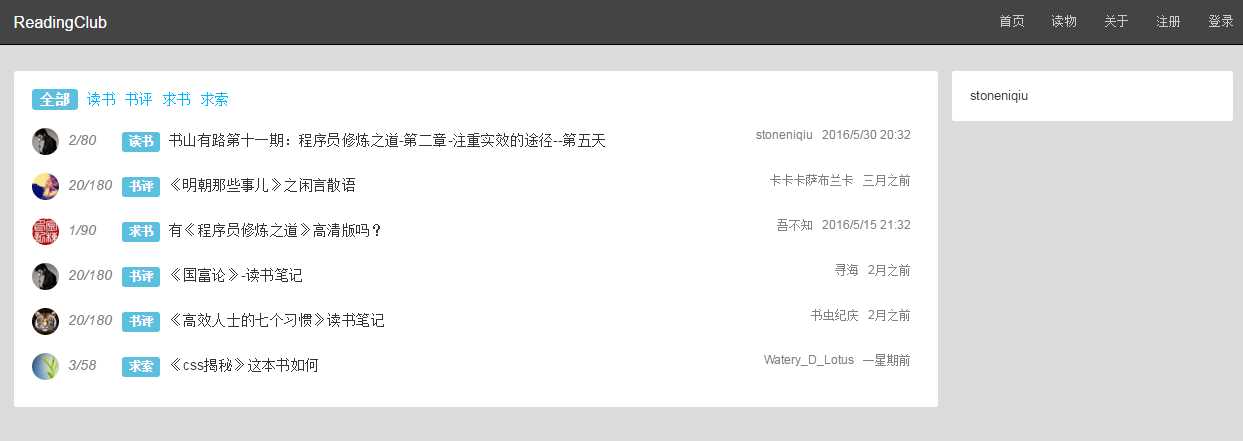标签:
上一节做了对Express做了简单的介绍,提出了controller,介绍了路由。这一节将重点放到视图和模型上,完成几个静态页面并部署到heroku上。
导航
前端布局使用bootstrap,从官网下载后置于public文件夹下。打开layout.jade 先做一个导航.
doctype html html head meta(name=‘viewport‘, content=‘width=device-width, initial-scale=1.0‘) title= title link(rel=‘stylesheet‘, href=‘/bootstrap/css/bootstrap.css‘) link(rel=‘stylesheet‘, href=‘/stylesheets/style.css‘) body nav.navbar.navbar-default.navbar-fixed-top.navbar-inverse .container .navbar-header a.navbar-brand(href=‘/‘) ReadingClub .collapse.navbar-collapse ul.nav.navbar-nav.pull-right li a(href=‘/‘) 首页 li a(href=‘/Books‘) 读物 li a(href=‘/About‘) 关于 li a(href=‘/Register‘) 注册 li a(href=‘/Login‘) 登录 #bodycontent.container block content footer.container .row .col-xs-12 small © stoneniqiu 2016 script(src=‘/javascripts/jquery-1.11.1.min.js‘) script(src=‘/bootstrap/js/bootstrap.min.js‘)
block content 上文有介绍,可以理解成一个占位符。因为现在还用不惯stylus,就直接写css了,这样vs还有智能提示。
style.css

body { font: 14px "Lucida Grande", Helvetica, Arial, sans-serif; background: gainsboro; } a { color: #00b7ff; } .navbar-default { background-color: #444; border-color: black; } .navbar-default .navbar-nav > li > a:hover, .navbar-default .navbar-nav > li > a:focus { color: #ffffff; background-color:#222; } .navbar-default .navbar-nav > li > a{ color: #ccc; } a.navbar-brand{color: #fff !important}
运行起来,看到导航条

如果访问注册和登录,因为之前没有设置相应的页面就会报404。

app.use(function (req, res, next) { var err = new Error(‘Not Found‘); err.status = 404; next(err); });
回头看layout.jade 没有一个html标签,直接是元素名或者样式名称开始,这种写法和sublime中写html相似,属性写在括号里,文字内容用空格隔开。元素的嵌套关系 通过严格的缩进来控制,这样的好处是代码量更少,层次更分明,但是代码一长,很不容易判断缩进的准确位置,没对齐很容易造成意外的嵌套。我现在的经验是从左往右的编写,而不是从上往下编写。也就是说,用jade写html的时候,先写好最外层的元素,然后在逐步写里面的子元素。而不是从上往下一个一个的写,这样就会出现缩进来带的困扰。
模型与视图
回到home.js,我们用JavaScript建立一个books模型,包含title,info,rating,img和tags。因为还没有使用数据库,这里直接创建。
books:

var books = [ { id: 0, title: "深入浅出Node.js", info: "朴灵 / 人民邮电出版社 / 2013-12-1 / CNY 69.00", rating: 5, img: "https://img3.doubanio.com/mpic/s27269296.jpg", tags: ["node", "深入浅出"], brief: ‘本书从不同的视角介绍了 Node 内在的特点和结构。由首章Node 介绍为索引,涉及Node 的各个方面,主要内容包含模块机制的揭示、异步I/O 实现原理的展现、异步编程的探讨、内存控制的介绍、二进制数据Buffer 的细节、Node 中的网络编程基础、Node 中的Web 开发、进程间的消息传递、Node 测试以及通过Node 构建产品需要的注意事项。最后的附录介绍了Node 的安装、调试、编码规范和NPM 仓库等事宜。本书适合想深入了解 Node 的人员阅读。‘ ,ISBN: 9787115335500 }, { id: 1, title: "程序员修炼之道 : 从小工到专家", info: "Andrew Hunt、David Thomas / 马维达 / 电子工业出版社 / 2005-1 / 48.00元", rating: 5, img: "https://img3.doubanio.com/mpic/s3957863.jpg", tags: ["程序人生", "软件开发"], brief: ‘《程序员修炼之道》由一系列的独立的部分组成,涵盖的主题从个人责任、职业发展,直到用于使代码保持灵活、并且易于改编和复用的各种架构技术。利用许多富有娱乐性的奇闻轶事、有思想性的例子以及有趣的类比,全面阐释了软件开发的许多不同方面的最佳实践和重大陷阱。无论你是初学者,是有经验的程序员,还是软件项目经理,本书都适合你阅读。‘ ,ISBN: 9787505397194 }, { id: 2, title: "Getting MEAN with Mongo, Express, Angular, and Node", info: "Simon Holmes / Manning Publications / 2015-11-26 / USD 44.99", rating: 4, img: "https://img3.doubanio.com/mpic/s27676844.jpg", tags: ["node", "web开发", "编程"], brief: ‘MEAN栈开发,比较详尽的的应用开发书籍‘ , ISBN: 9781617292033 } ]; res.render(‘books‘, { title: ‘Books‘, books: books }); jade 模型其实就是一个json对象,接下来我们修改books页面的布局。这里用左右布局,稍加调整 extends layout block content .row .col-md-9.page each book in books .row.booklist .col-md-2 img(src=‘#{book.img}‘) .col-md-10 p a(href="/Detail/#{book.id}")=book.title p=book.info p - for (var i = 1; i <= book.rating; i++) span.glyphicon.glyphicon-star - for (i = book.rating; i < 5; i++) span.glyphicon.glyphicon-star-empty p.tags each tag in book.tags span=tag .col-md-3 .userinfo p stoneniqiu
res.render(‘books‘, { title: ‘Books‘, books: books });
在home.js中加入books,模型其实就是一个json对象,接下来我们修改books页面的布局。这里用左右布局,稍加调整,
extends layout block content .row .col-md-9.page each book in books .row.booklist .col-md-2 img(src=‘#{book.img}‘) .col-md-10 p a(href="/Detail/#{book.id}")=book.title p=book.info p - for (var i = 1; i <= book.rating; i++) span.glyphicon.glyphicon-star - for (i = book.rating; i < 5; i++) span.glyphicon.glyphicon-star-empty p.tags each tag in book.tags span=tag .col-md-3 .userinfo p stoneniqiu
得到效果:

当然这些都还是静态的,接下来介绍下jade引擎。jade是一个高性能的模板引擎,用于node。
借助bootstrap的栅栏布局,分成左右两部分。extends layout 表示引入layout母版页,而layout中的block content 就会被当前页面的block content中的内容替换掉。同样可 以定义多个block
//- layout.jade
doctype html
html
head
block title
title Default title
body
block content
引用页面:
//- index.jade
extends layout
block title
title Article Title
block content
h1 My Article
生成的html:
<!doctype html> <html> <head> <title>Article Title</title> </head> <body> <h1>My Article</h1> </body> </html>
each book in books
表示循环输出模型,在Asp.net MVC的视图中,需要先定义Model的类型。jade省掉了这个model,直接获取模型的属性。同样也支持for循环,前面的‘-’号不可少。
- for (var i = 1; i <= book.rating; i++) span.glyphicon.glyphicon-star - for (i = book.rating; i < 5; i++) span.glyphicon.glyphicon-star-empty
空格赋值,这个空格不能少,不然jade会把ptext视为一个元素。空格后方都认为是字符串。
p text 输出 <p>text<p>
所以如果是输出变量,一定要用‘=’赋值。
a(href="/Detail/")=book.title
但如果是字符串组合输入,应该用#{}
img(src=‘#{book.img}‘)
p 读过#{book.title}
如果不想转义内容 !{},- var 表示定义变量 ,相当于Razor中的@{}
- var riskyBusiness = "<em>Some of the girls are wearing my mother‘s clothing.</em>"; .quote p Joel: !{riskyBusiness}
输出
<div class="quote"> <p>Joel: <em>Some of the girls are wearing my mother‘s clothing.</em></p> </div>
如果是增加元素属性,则更在元素后面的括号里完成
a(href="/Detail/")=book.title
输出:
<a href="/Detail/">深入浅出Node.js</a>
如果是多个属性用逗号隔开,也可以换行
a(class=‘button‘, href=‘google.com‘)
input(
type=‘checkbox‘
name=‘agreement‘
checked
)
还可以加入表达式
- var authenticated = true
body(class=authenticated ? ‘authed‘ : ‘anon‘)
而Razor要在元素里面写表达式就有点丑陋。
@{ var ischeck = true; } <input type="checkbox" @if (ischeck) { @Html.Raw("class=‘selected‘") } />
这里用子视图还不太准确,我们已经知道通过extends 和 block 来引入母版页,并按模块取代内容。而子视图主要是强调复用,是嵌入到别的视图文件中。jade是用mixin(混合)定义一个部分视图,用‘+’使用 例如:
mixin list
ul
li foo
li bar
li baz
+list
+list
输出

比如把页面上显示星星的部分提出来,在view文件夹下建一个_include文件夹,并创建一个rating.jade文件:
mixin outputRating(rating) - for (var i = 1; i <= rating; i++) span.glyphicon.glyphicon-star - for (i = rating; i < 5; i++) span.glyphicon.glyphicon-star-empty
这样在页面上引用
include _includes/rating
然后在指定位置输出,主要有‘+’号。
p +outputRating(book.rating)
同理创建了detail.jade 和index.jade
detail.jade

extends layout
include _includes/rating
block content
.row
.col-md-9.page.bookdetail
h3=book.title
.row
.col-md-2
img(src=‘#{book.img}‘)
.col-md-10
p=book.info
p
+outputRating(book.rating)
p.tags
each tag in book.tags
span=tag
p ISBN:#{book.ISBN}
h3 内容简介
p.brief=book.brief
.col-md-3
.userinfo
p stoneniqiu
index.jade

extends layout
block content
.row
.col-md-9.page
.row.topictype
a.label.label-info(href=‘/‘) 全部
a(href=‘/‘) 读书
a(href=‘/‘) 书评
a(href=‘/‘) 求书
a(href=‘/‘) 求索
each topic in topics
.row.topiclist
img(src=‘#{topic.img}‘)
span.count
i.coment=topic.commentCount
i /
i=topic.visitedCount
span.label.label-info=topic.type
a(href=‘/‘)=topic.title
span.pull-right=topic.postTime
a.pull-right.author(href=‘/‘)=topic.author
.col-md-3
.userinfo
p stoneniqiu

至此,我们创建了三个静态页面,基本熟悉了jade语法。当然jade不止这些,后期随着项目的深入再不断的探索。
目前我已经将代码提交到github上,然后部署在heroku上。
github:https://github.com/stoneniqiu/ReadingClub 有兴趣的朋友可以一起开发学习。
观摩请戳:https://stoneniqiu-mean.herokuapp.com/

heroku提供了三百兆的免费空间,还有个规则的域名,如何部署请移步:三步将Node应用部署到Heroku上
jade官网:http://jade-lang.com/
jade开源:https://github.com/jadejs/jade
标签:
原文地址:http://www.cnblogs.com/stoneniqiu/p/5551019.html